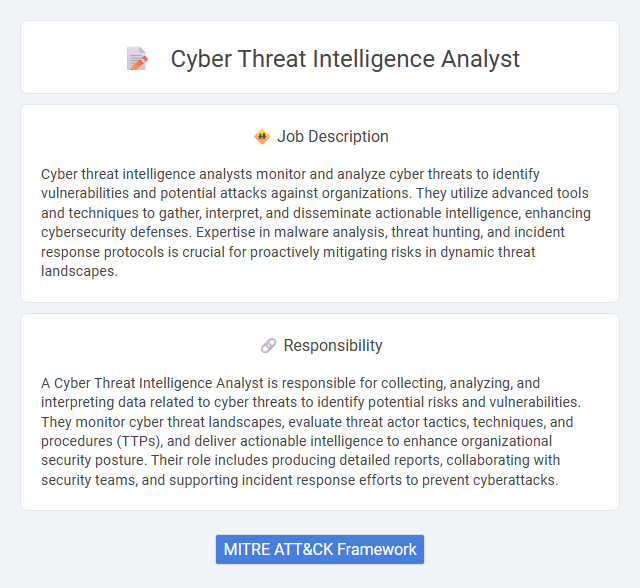
Cyber threat intelligence analysts monitor and analyze cyber threats to identify vulnerabilities and potential attacks against organizations. They utilize advanced tools and techniques to gather, interpret, and disseminate actionable intelligence, enhancing cybersecurity defenses. Expertise in malware analysis, threat hunting, and incident response protocols is crucial for proactively mitigating risks in dynamic threat landscapes.
Individuals with strong analytical skills and a keen interest in cybersecurity are likely to excel as cyber threat intelligence analysts. Those who can handle high-pressure situations and have a curiosity for understanding evolving cyber threats may find the role fulfilling. People less comfortable with fast-paced environments or detailed technical analysis might struggle to adapt to this position.
Qualification
A Cyber Threat Intelligence Analyst must have a strong foundation in cybersecurity principles, often supported by a bachelor's degree in computer science, information technology, or a related field. Proficiency in threat analysis tools, malware analysis, and understanding of attack vectors and cyber adversary tactics is essential. Certifications such as Certified Threat Intelligence Analyst (CTIA) or GIAC Cyber Threat Intelligence (GCTI) enhance credibility and demonstrate specialized expertise in identifying and mitigating cyber threats.
Responsibility
A Cyber Threat Intelligence Analyst is responsible for collecting, analyzing, and interpreting data related to cyber threats to identify potential risks and vulnerabilities. They monitor cyber threat landscapes, evaluate threat actor tactics, techniques, and procedures (TTPs), and deliver actionable intelligence to enhance organizational security posture. Their role includes producing detailed reports, collaborating with security teams, and supporting incident response efforts to prevent cyberattacks.
Benefit
A Cyber Threat Intelligence Analyst likely enhances an organization's security posture by identifying emerging threats and vulnerabilities before they impact systems. Their insights probably contribute to more informed decision-making, reducing the risk of cyberattacks and financial losses. This role may also offer professionals continuous learning opportunities in advanced cybersecurity tactics and intelligence analysis.
Challenge
Cyber threat intelligence analyst roles likely present significant challenges in interpreting vast amounts of complex data to predict and counteract evolving cyber threats. They probably face the probability of encountering sophisticated attack vectors that require continuous learning and adaptation. Effective communication of findings to technical and non-technical stakeholders might also pose a frequent challenge.
Career Advancement
Cyber threat intelligence analysts leverage advanced skills in data analysis, threat modeling, and cybersecurity frameworks to identify and mitigate evolving cyber risks, positioning themselves for rapid career advancement into senior analyst, cybersecurity consultant, or threat intelligence manager roles. Mastery of tools such as SIEM platforms, CTI feeds, and intrusion detection systems enhances their value within organizations and the cybersecurity sector. Continuous certification in CISSP, CEH, or GIAC, coupled with experience in incident response and threat hunting, significantly accelerates progression to leadership and strategic positions.
Key Terms
MITRE ATT&CK Framework
Cyber threat intelligence analysts leverage the MITRE ATT&CK Framework to systematically identify, categorize, and understand adversary tactics, techniques, and procedures (TTPs) used in cyberattacks. Utilizing ATT&CK matrices, analysts correlate threat data with specific attack behaviors, enhancing detection, mitigation, and response strategies across diverse security environments. Proficiency in integrating ATT&CK into threat hunting and incident response workflows significantly improves an organization's capability to anticipate and neutralize evolving cyber threats.
 kuljobs.com
kuljobs.com